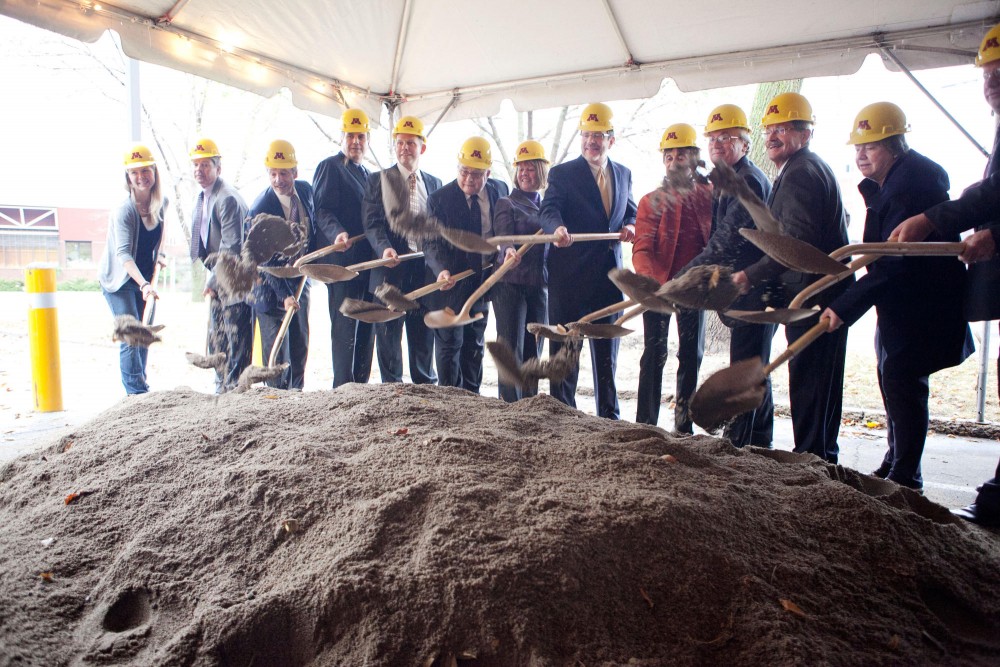Donning construction hard hats, a handful of University of Minnesota administrators, faculty and state officials gathered outside Akerman Hall Wednesday evening with shovels and started digging.
The groundbreaking ceremony for a new physics and nanotechnology building took place on a rain-soaked Wednesday, more than a year after University administration first requested state funding for the project.
âÄúItâÄôs a dream come true,âÄù said Mos Kaveh, associate dean for the College of Science and Engineering.
CSE Dean Steven Crouch, CSE had pushed the buildingâÄôs construction for years, and could âÄúhardly wait to stick a shovel in the ground.âÄù Crouch said he was thrilled to see the project come to life.
Construction on the $83 million building on the corner of Beacon and Union streets will officially begin in November. It comes after a tumultuous journey and multiple funding challenges. The state Legislature approved funding for the building in 2010, but it was vetoed by former Gov. Tim Pawlenty.
Pawlenty recommended cuts to the University’s request for the projectâÄôs funding last year, prompting former University President Bob Bruininks and some physics professors to appeal before the Legislature to rescue the building.
The state eventually granted $4 million in planning money to the project, and the University matched half the funding to keep the project on track.
MinnesotaâÄôs government shutdown this summer cast further uncertainty on the project as Gov. Mark DaytonâÄôs planned $100 million for University projects was jeopardized.
The state finally approved $51.3 million for the project in the bonding bill passed at the shutdownâÄôs conclusion in July. The University will cover the remaining third of the projectâÄôs cost with help from private donations.
But CSE is still trying to raise an additional $10 million to cover its part of the costs âÄî the school already has $6 million set aside, Kaveh said.
At the groundbreaking ceremony, President Eric Kaler said he was grateful the Legislature came through.
âÄúThis is no ordinary project,âÄù said Linda Cohen, chairwoman of the UniversityâÄôs Board of Regents. She said the building would increase research money for the University and make the school a national leader in nanotechnology.
âÄúItâÄôs a lot to ask for one building,âÄù she said, adding âÄúWe have raised our profile among our peers.âÄù
By 2014, a considerable number of jobs will involve nanotechnology, said Susan Von Mosch, director of the Minnesota Office of Higher Education. Besides the effect of the research, she said the construction would also create jobs for the state.
The almost 60,000-square-foot building will feature a combination of about 40 physics and nanotechnology research laboratories.
About 200 doctorate and graduate students will help staff the complex, Crouch said.
The nanotechnology department is currently scattered throughout University campuses and would receive about a quarter of the buildingâÄôs space.
âÄúProgress in nanotechnology, and in particular, in the application of nanotechnology, continues to accelerate,âÄù said Stephen Campbell, a director at the College of Science and Engineering.
Applications for the technology, including nanomedicine and energy production, âÄúhold some of the greatest potential for positively impacting humanity,âÄù Campbell said.
Hundreds of University researchers are involved in some aspect of nanotechnology, he said.
Campbell expects usage of the facility will grow, not only among University scientists, but also among researchers from the private sector and other academic institutions.
The building is expected to be completed in November 2013, according to Matt Stringfellow, a senior project manager.


